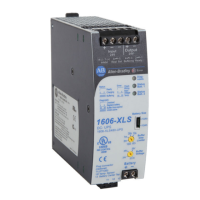14 Rockwell Automation Publication 1606-RM008A-EN-P - November 2021
DC-UPS - 24V, 20 A, 480 W Reference Manual
sensor is installed, the end-of-charge-voltage is fixed to a value that
corresponds to a battery temperature of 40 °C.
Use a PT1000 temperature sensor or battery modules, which have this sensor
already included. A list of suitable PT1000 temperature sensors from different
vendors can be provided.
Setting of battery size selector
small battery < 10
Ah
large battery >
10 Ah
Allowed battery sizes Nom
3.9 Ah…10 Ah
(1)
(1) Batteries smaller than 6Ah are only recommended when the load current is below 10 A.
10 Ah… 150 Ah
Battery voltage Nom 24V 24V 2x 12V batteries in series
Battery charging current Typ 1.5 A 3 A In constant current mode
End-of-charge-voltage
Typ 2 x13.25V 2 x13.25V
center-tap connected, no
temperature sensor connected
Typ 26.5V 26.5V
center-tap not connected, no
temperature sensor connected
Typ
2x 13.1 …14.2V
(2)
(2) The end-of-charge voltage depends on the battery temperature. At 20 °C the end-of-charge voltage is set to 13.6V (rsp. 27.2V)
and changes with -18mV/°C for 12V batteries and -36mV/°C for 24V batteries but not higher than 14.2V rsp. 28.4V.
2x 13.1 …14.2V
center-tap connected, temperature
sensor connected
Typ 26.2V…28.4V 26.2V…28.4V
center-tap not connected,
temperature sensor connected
Temperature range for which
the charging process is
enabled
(3)
(3) Corresponds to the temperature readings of the external temperature sensor of the battery and is not the surrounding air
temperature of the DC-UPS. Frequent charging below +5 °C (41 °F) reduced the lifetime of the battery and should be avoided.
Low temperatures increase the battery impedance and also change the battery characteristics. This could result in a false
“replace battery” signal or an unexpected interruption of a buffer event, especially with small batteries. To avoid this, the
temperature range for charging is limited at low temperatures depending on the battery size. If the end application requires
temperatures below +5 °C, it is recommended to use batteries >10 Ah.
Nom -10…+50°C -40… +50°C
Deep-discharge protection
Typ 10.5V / 9.0V 10.5V / 9.0V
At 0 A / 20 A buffer current, center-
tap connected, Buffering stops as
soon as one battery falls below this
value.
Typ 21V / 18V 21V / 18V
At 0 A / 20 A buffer current, center-
tap not connected
Required min battery voltage
to allow charging
(4)
(4) Below this voltage level, charging does not start and the DC-UPS reports “check wiring”.
Min 2 x 7V 2 x 7V
center-tap connected
Min 14V 14V
center-tap not connected
Battery charging time
(5)
(5) The listed charging time applies for a complete discharged battery until the DC-UPS indicated “Ready” with the green status
LED. In practice, the charging time can be much shorter, since the battery is not completely discharged. An extended
charging time is likely caused by a defective or old battery.
Max 4 h 40 mins — for a 7 Ah battery
Max 8 h 4 h for a 12 Ah battery
Max 44 h 22 h for a 65 Ah battery
Max 94 h 47 h for a 140 Ah battery
Battery discharge current Typ 170 mA 170 mA
in battery mode at no output
current

